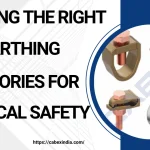In the realm of electrical systems, the principle of earthing plays a crucial role in ensuring safety, reliability, and efficient operation. It is an integral concept that encompasses various components and techniques to provide a path for the dissipation of electrical faults and the protection of both people and equipment. In this blog article, we will delve into the intricacies of the principle of earthing, exploring its significance, implementation, and the key role played by earthing system accessories. So, let’s embark on this enlightening journey to unravel the mysteries of earthing.
Understanding the Significance of Earthing
At its core, the principle of earthing aims to establish a connection between an electrical system and the Earth, creating a safe path for electrical current to flow in the event of a fault. It is based on the fundamental understanding that electrical energy seeks the path of least resistance. By providing an intentional and controlled pathway through earthing, the risks associated with electrical faults can be mitigated.
The Role of Earthing System Accessories
Earthing system accessories are integral components that enhance the effectiveness of the earthing system. They serve as connectors, conductors, and protectors, ensuring a reliable and low-impedance path for fault current to dissipate safely. These accessories are specifically designed to withstand various environmental conditions, mechanical stresses, and electrical demands. They include but are not limited to:
- Earth Electrodes: Earth electrodes, such as copper rods or plates, establish the physical connection between the electrical system and the Earth. They are buried deep into the ground to provide a reliable and stable reference point for the earthing system.
- Earthing Conductors: These conductors facilitate the flow of electrical current between different components of the earthing system. They are typically made of high-quality copper or aluminum, chosen for their excellent conductivity and corrosion resistance. Earthing conductors ensure the safe dissipation of fault currents, preventing damage to equipment and reducing the risk of electric shock.
- Earth Bars: Earth bars are metal bars that serve as distribution points for the earthing system. They are equipped with multiple terminals or connections to accommodate various conductors, allowing for easy installation and maintenance. Earth bars are often installed in switchgear rooms, substations, or distribution panels to ensure effective earthing throughout the electrical installation.
- Earthing Clamps: These clamps are essential for establishing secure connections between different components of the earthing system. They are designed to grip conductors firmly, maintaining low resistance and ensuring reliable electrical continuity. Earthing clamps come in various designs, such as screw clamps or compression clamps, to accommodate different installation requirements.
- Earth Fault Detectors: Earth fault detectors are specialized devices that continuously monitor the integrity of the earthing system. They detect any abnormalities, such as insulation failures or excessive earth leakage currents, and provide early warning signals. Earth fault detectors play a crucial role in identifying potential hazards and facilitating timely maintenance or repairs.
Implementation of the Principle of Earthing
The implementation of the principle of earthing involves a systematic approach to ensure the overall safety and reliability of an electrical system. Here are the key steps involved in establishing an effective earthing system:
- Design and Planning: The earthing system should be designed based on thorough analysis and consideration of the specific electrical installation’s requirements. Factors such as soil resistivity, fault currents, and equipment ratings need to be taken into account to determine the appropriate size and configuration of earthing system accessories.
- Selection of Earthing Materials: The selection of high-quality earthing materials is crucial for achieving optimal performance and longevity. Copper is widely preferred for earthing conductors and electrodes due to its excellent electrical conductivity and resistance to corrosion. Aluminum is also used in certain applications, offering a cost-effective alternative with adequate conductivity.
- Installation and Connection: Proper installation of earthing system accessories is vital to ensure a low-impedance connection between various components. The electrodes should be buried deep enough to establish good contact with the Earth, while conductors and clamps should be securely connected to minimize resistance. Regular testing and periodic maintenance are essential to detect and address any potential issues promptly.
- Integration with Protective Devices: The earthing system should be seamlessly integrated with protective devices, such as circuit breakers or residual current devices (RCDs). These devices can quickly detect faults and interrupt the circuit’s supply, preventing electrical shocks and equipment damage. Coordination between earthing and protective devices is crucial for optimal system performance.
The Significance of Maintaining a Proper Earthing System
Once an effective earthing system is established, it is imperative to ensure its ongoing maintenance and periodic testing. The performance of the earthing system can be affected by various factors, including soil conditions, moisture levels, and corrosion. Regular inspections and testing are crucial to identify any deterioration or faults that may compromise the system’s integrity. By maintaining a proper earthing system, the following benefits can be realized:
- Electrical Safety: A well-maintained earthing system minimizes the risk of electric shock to individuals by providing a low-resistance path for fault currents. In the event of a fault, the fault current is effectively directed through the earthing system, triggering protective devices and isolating the faulty circuit.
- Equipment Protection: Electrical equipment, such as transformers, generators, and distribution panels, can be vulnerable to damage caused by electrical faults. By promptly dissipating fault currents, the earthing system safeguards the equipment, preventing costly repairs, downtime, and potential hazards.
- Stability of Power Supply: An efficient earthing system helps maintain the stability of the power supply by reducing voltage fluctuations and minimizing the impact of transient events, such as lightning strikes. It aids in achieving a reliable and uninterrupted flow of electricity, enhancing the overall performance of electrical systems.
- Compliance with Regulations: In many jurisdictions, compliance with electrical safety regulations is mandatory. Proper earthing is a critical requirement outlined in these regulations, and failure to adhere to the specified standards can result in penalties, legal liabilities, and compromised insurance coverage.
- Protection against Electromagnetic Interference: An effective earthing system also plays a role in mitigating electromagnetic interference (EMI) and radio frequency interference (RFI). By providing a reference point and a path for unwanted electrical currents, the system helps minimize the impact of EMI/RFI on sensitive electronic equipment, ensuring their optimal operation.
Incorporating the Principle of Earthing in Different Applications
The principle of earthing is applicable across various industries and settings, including residential, commercial, industrial, and utility sectors. Let’s explore how the principle of earthing is incorporated in different applications:
- Residential Buildings: In residential buildings, the principle of earthing is crucial to protect occupants from electrical hazards. The earthing system is typically integrated into the electrical distribution panel, with earthing electrodes securely buried in the ground. This ensures that any fault currents are safely directed to the ground, preventing electric shock and minimizing damage to appliances.
- Commercial Establishments: Commercial buildings, such as offices, retail spaces, and healthcare facilities, require reliable and safe electrical systems. The principle of earthing is employed to protect employees, customers, and critical equipment. It is essential to establish a low-resistance earthing connection throughout the premises, including distribution panels, data centers, and communication systems.
- Industrial Facilities: Industrial environments often involve complex electrical systems with heavy machinery, motors, and high-power equipment. The principle of earthing is of paramount importance to protect personnel, prevent equipment damage, and maintain operational continuity. Specialized earthing techniques, such as equipotential bonding and grounding grids, are employed to ensure effective earthing in industrial settings.
- Renewable Energy Systems: The rapid growth of renewable energy sources, such as solar and wind power, necessitates the implementation of proper earthing systems. These systems involve inverters, transformers, and arrays of photovoltaic panels. By effectively earthing these components, the risk of electrical faults and fire hazards can be mitigated, ensuring the safe and efficient operation of renewable energy installations.
- Transmission and Distribution Networks: In the utility sector, transmission and distribution networks require robust earthing systems to ensure the safety of personnel and protect critical infrastructure. Substations, transmission towers, and grounding grids are carefully designed and maintained to facilitate the safe dissipation of fault currents and minimize the impact of lightning strikes.
End-note
In end-note, the principle of earthing is a fundamental concept in electrical systems that ensures safety, reliability, and protection against electrical faults. By establishing a connection between an electrical installation and the Earth, earthing provides a controlled path for fault current to dissipate harmlessly. The utilization of earthing system accessories, such as earth electrodes, conductors, bars, clamps, and fault detectors, further enhances the effectiveness of the earthing system. Through careful planning, material selection, installation, and integration with protective devices, an optimal earthing system can be achieved, safeguarding both individuals and equipment. Remember, the principle of earthing is not just an electrical necessity; it is a crucial element in promoting a secure and resilient environment for electrical installations.








